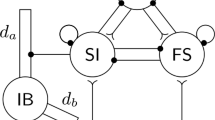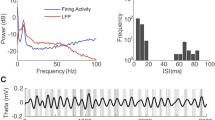Abstract.
Spatial patterns of theta-rhythm activity in oscillatory models of the hippocampus are studied here using canonical models for both Hodgkin's class-1 and class-2 excitable neuronal systems. Dynamics of these models are studied in both the frequency domain, to determine phase-locking patterns, and in the time domain, to determine the amplitude responses resulting from phase-locking patterns. Computer simulations presented here demonstrate that phase deviations (timings) between inputs from the medial septum and the entorhinal cortex can create spatial patterns of theta-rhythm phase-locking. In this way, we show that the timing of inputs (not only their frequencies alone) can encode specific patterns of theta-rhythm activity. This study suggests new experiments to determine temporal and spatial synchronization.
Similar content being viewed by others
Author information
Authors and Affiliations
Additional information
Received: 31 July 1998 /Accepted in revised form: 20 April 1999
Rights and permissions
About this article
Cite this article
Borisyuk, R., Hoppensteadt, F. Oscillatory models of the hippocampus: A study of spatio-temporal patterns of neural activity. Biol Cybern 81, 359–371 (1999). https://doi.org/10.1007/s004220050568
Issue Date:
DOI: https://doi.org/10.1007/s004220050568




